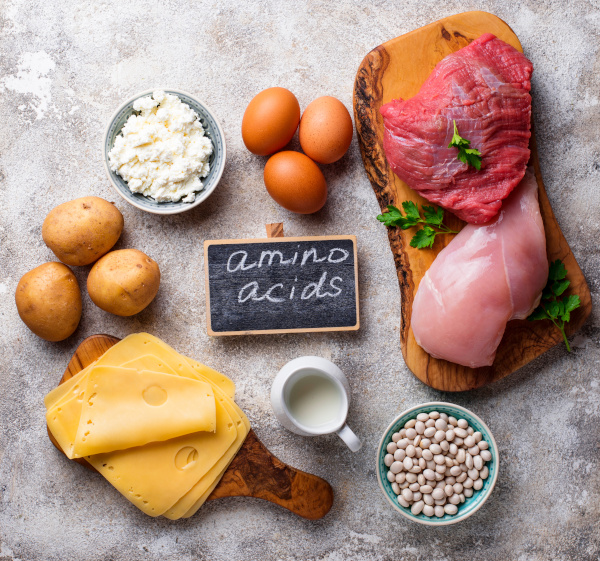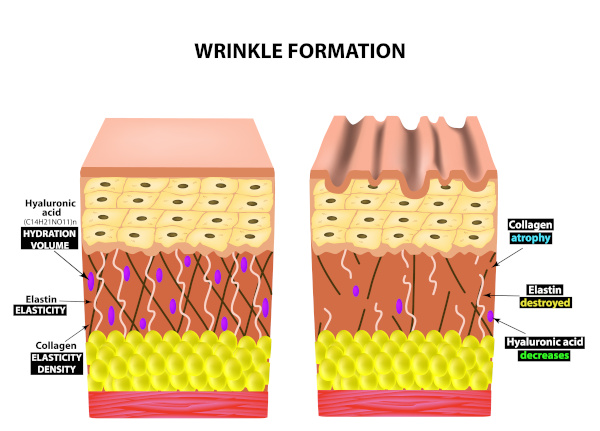The human body needs a constant supply of fresh, beneficial nutrients in order to survive and thrive. Amino acids form an essential component of our daily nutritional intake for a variety of reasons and benefits. There are 9 essential amino acids the body needs from our diet, but what amino acids and how do we benefits from them?

What are Amino Acids?
Before we go into listing the various essential amino acids, let’s just take a moment to understand what they are and the functions they perform. Amino acids play numerous important roles in the body including
- protein synthesis,
- energy creation,
- digestion,
- creation of hormones
- hemoglobin production
- creation / synthesis of Elastin and Collagen for connective tissue (i.e taught healthy looking skin)
- immune system health and function,
- neurotransmitters for sleep cycles and appetite control.
The Science bit! Amino acids are compounds that contain amine (-NH2) and Carboxyl (-COOH) functional groups. The key elements of amino acids are : Carbon, Hydrogen, Oxygen and Nitrogen. While there are about 500 naturally occurring amino acids, only 20 appear in the genetic code. The genetic code is a set of rules used by living cells to translate information coded with genetic material (DNA or mRNA sequences) into protein. It is the genetic coding which defines how sequences are defined in the creation of proteins and which amino acid will be added next during this protein synthesis. These acids include the 22 protein building amino acids.
Amino acids can be used by the body to create various strains of proteins for use within the body as required by our various physiological systems including muscle building, tissue maintenance, the creation of collagen for healthy skin structure and many other functions. Part of these amino acid groups are the Branched Chain Amino Acids (BCAA’s) bodybuilders use to increase muscle mass – which we will discuss in another article.
In the form of protein, amino acids form the 2nd largest component (of which water is the largest) of human muscles and tissues. Beyond this role they participate in a number of processes such as neurotransmitters and bio-synthesis.
Of the 21 amino acids common to all life forms, there are 9 humans cannot create within the various physiological processes within the human body….
Here are the 9 Essential Amino Acids..
Phenylalanine. Phenylalanine is converted by your body into neurotransmitters Tyrosine, Dopamine, Epinephrine and Norepinephrine. Phenylalanine also plays an important role in the function and structure of protein, enzymes and the production of other amino acids.
Valine. Valine is one of 3 Branched Chain Amino Acids (BCAA’s) and helps stimulate muscle growth and regeneration. It is also involved in energy production.

Valine, a vital amino acid, holds a pivotal role in promoting overall health and well-being. As a branch-chain amino acid (BCAA), valine aids in muscle repair, growth, and maintenance, making it crucial for active individuals and athletes.
Moreover, valine contributes to balanced nitrogen levels in the body, supporting immune function and tissue regeneration. Research suggests its potential in reducing fatigue and enhancing endurance during exercise [1].
Dietary sources like meat, dairy, and legumes provide this essential amino acid. Incorporating valine-rich foods can contribute to muscle health, immunity, and sustained physical performance.
Valine works with Leucine (below) in the creation and repair of muscles and Isoleucine (also below) in the metabolism of muscle tissue.
Physical fitness and health are highly attractive qualities in humans. Qualities that stem from our ancestors. Our “primal urge” and motivation to check out the opposite sex for partnering / mating. Just 1 of 12 reasons to lose weight.
Threonine. Threonine is the main component of the structural proteins Collagen and Elastin.

Threonine is a critical contributor to the creation of collagen and elastin – the fundamental proteins responsible for maintaining skin integrity and elasticity [2].
Collagen provides structural support, while elastin imparts skin’s flexibility and resilience [3].
Threonine’s involvement in protein biosynthesis is vital for the formation of these connective tissues, which play a significant role in skin health. Studies highlight the importance of amino acids like threonine in collagen and elastin production, underscoring their impact on skin’s appearance and texture [4].
Lysine (below) also contributes to the creation of collagen and elastin.
A diet rich in threonine-rich sources such as meats, dairy, legumes, and nuts can contribute to sustaining youthful skin by supporting these crucial protein formations. Collagen and Elastin are very important for skin and connective tissue. Threonine also plays an important role in fat metabolism and immune system function.
Tryptophan. Tryptophan is a precursor to Serotonin (a neurotransmitter that regulates appetite, sleep and mood) that offers several health benefits:
- Mood Enhancement: Tryptophan helps in the production of serotonin, a neurotransmitter that regulates mood. Adequate levels of tryptophan can contribute to improved mood and reduced symptoms of depression and anxiety[12].
- Better Sleep: Tryptophan is known for its sleep-inducing properties. It helps in the production of melatonin, a hormone that regulates sleep-wake cycles. Consuming tryptophan-rich foods or supplements may aid in improving sleep quality[13].
- Appetite Regulation: Tryptophan plays a role in appetite regulation. It can help reduce cravings and promote satiety, which may contribute to weight loss or weight maintenance[12][13]
- Mental Health Support: Tryptophan has been shown to have positive effects on mental health. It may help alleviate symptoms of depression, irritability, and anxiety[12][13].
- Nutrient Absorption: Tryptophan helps maintain the body’s correct nitrogen balance and supports the absorption of other nutrients[14]
Methionine. Methionine is an essential amino acid that offers several health benefits. Methionine plays an important role in metabolism and detoxification (cleansing) of your body. Methionine is also necessary for tissue growth and aids absorption of essential minerals Zinc and Selenium. Here are some key points to highlight about the health benefits of methionine.
- Antioxidant: Methionine is an antioxidant that may help protect the body from damage caused by ionizing radiation and detoxify harmful substances in the body[15].
- Memory Recall: One trial found that methionine may improve memory recall in people with AIDS-related nervous system degeneration[16]
- Metabolism and Growth: Methionine supplies sulfur and other compounds required by the body for normal metabolism and growth. It is needed to make protein and other compounds in the body[16][17].
- Liver Health: Methionine may help improve liver damage, especially when used alongside other treatments[18]. It also belongs to a group of compounds called lipotropics, or chemicals that help the liver process fats (lipids) [16].
- Bone Strength: Methionine may help athletic performance and even weight loss due to its effects on bones. It may also help build bone strength[19].
It’s important to note that most healthy adults consume enough methionine through their regular diet. However, if you notice signs of liver damage, poor bone health, or other health issues, increasing your methionine intake may be beneficial. Incorporating methionine-rich foods such as eggs, fish, and some meats into your diet can help ensure an adequate supply of this essential amino acid[20][19].
Leucine. Another Branched Chain Amino Acid, Leucine is crucial for protein creation and muscle repair. Leucine also helps regulate blood sugar levels, stimulates wound healing and produces growth hormones.
Isoleucine. The 3rd BCAA on this list, Isoleucine is used in the metabolism of muscle in which it is heavily concentrated. Isoleucine is also important for the immune system, hemoglobin production and energy creation.
Lysine. Lysine holds a myriad of health benefits and plays major roles in protein creation and supports muscle growth and repair [5]. Lysine also aids in the absorption of Calcium for bone strength [7] and the production of hormones and enzymes. It is also important for the creation of energy, immune system functioning and the production of elastin and collagen. Lysine’s role in collagen synthesis is vital for skin, bone, and connective tissue health [6].
Furthermore, Lysine facilitates calcium absorption, contributing to bone strength [7]. Lysine’s antiviral properties are valuable in managing herpes simplex virus outbreaks[8]. Additionally, lysine supports immune function [9], aids enzyme and hormone production[10], and participates in energy metabolism[11].

Incorporating lysine-rich foods such as meats, dairy, legumes, and beans can harness these advantages for overall well-being.
Cucumber is surprisingly rich in vitamins, minerals and amino acids yet very low in carbs and calories. A delicious and easy healthy addition to any diet that brings many health benefits.
Hystidine. Histidine is used by the body to create Histamine – a neurotransmitter that is vital to immune system response, digestion, sexual function and sleeping cycles. Hystidine is also essential for maintaining the myelin sheath that surrounds and protects your nerve cells.
6 Conditionally Essential Amino Acids
In addition to the above list, there are an additional 11 amino acids we actually need. The following 6 amino acids are considered “conditionally essential amino acids“. That is to say their synthesis within the human body is dependant upon other pathophysiological conditions.
These 6 Conditionally Essential Amino Acids are : –
- Arginine
- Cysteine
- Glycine
- Glatamine
- Proline
- and Tyrosine
6 Non Essential Amino Acids
None-essential amino acids are the amino acids we can create within the human body by metabolising other nutrients. Non-essential amino acids, including alanine, aspartic acid, asparagine, glutamic acid, serine, and selenocysteine, provide a range of benefits for overall health. Here are the 6 non-essential amino acids.
- Alanine is used in glucose metabolism and supports energy production during intense exercise.
- Aspartic Acid. Aspartic acid aids in detoxification processes, neurotransmitter production, and immune system function.
- Asparagine. Asparagine contributes to brain health, aiding in neurotransmitter synthesis.
- Glutamic Acid. Glutamic acid is a vital neurotransmitter and is important for cognitive function and learning.
- Serine. Serine participates in the synthesis of important molecules like proteins, phospholipids, and nucleic acids, supporting cell structure and growth.
- and Selenocysteine. Selenocysteine, although considered “non-essential,” is only found in specific proteins involved in antioxidant defense systems, regulating thyroid hormone metabolism, and supporting immune function
While these amino acids are deemed non-essential because the body can synthesize them, their availability from dietary sources or supplementation can enhance their functional roles. Foods rich in protein, such as meats, dairy, legumes, nuts, and seeds, provide ample amounts of these amino acids. Incorporating a diverse range of these amino acids through a balanced diet can contribute to various physiological processes, promoting overall well-being and optimal functioning of the body’s systems.
References and Citations
[1]Blomstrand, E., Hassmén, P., Ekblom, B., & Newsholme, E. A. (1991). Administration of branched-chain amino acids during sustained exercise—effects on performance and on plasma concentration of some amino acids. European journal of applied physiology and occupational physiology, 63(2), 83-88.
[2] Proksch, E., Schunck, M., Zague, V., Segger, D., Degwert, J., & Oesser, S. (2014). Oral intake of specific bioactive collagen peptides reduces skin wrinkles and increases dermal matrix synthesis. Skin Pharmacology and Physiology, 27(3), 113-119.
[3] Uitto, J. (1997). The role of elastin and collagen in cutaneous aging: intrinsic aging versus photoexposure. Journal of drugs in dermatology: JDD, 32-37.
[4] Solomon, M. (2007). Nutritional factors in skin health. Clinics in Dermatology, 25(6), 535-543
[5] Antonio, J., & Gonyea, W. J. (1993). Role of muscle fiber types in muscle hypertrophy: implications for muscle-building athletes. Sports Medicine, 16(6), 381-397
[6] Bae, J. H., Jo, C., Kwon, I. K., & Lee, H. G. (2012). Influence of dietary lysine restriction and environmental temperature on muscle protein turnover and heat production in growing pigs. Asian-Australasian Journal of Animal Sciences, 25(5), 668-674.
[7] Heaney, R. P., & Nordin, B. E. (2002). Calcium effects on phosphorus absorption: implications for the prevention and co-therapy of osteoporosis. Journal of the American College of Nutrition, 21(3), 239-244.
[8] Griffith, R. S., Walsh, D. E., Myrmel, K. H., & Thompson, R. W. (1987). Success of L-lysine therapy in frequently recurrent herpes simplex infection. Dermatology, 175(4), 183-190.
[9] Li, Y., Li, X., Hussain, T., & Jiang, Y. (2018). Lysine: A review of its physiology and role in nutrition. Journal of Animal Science and Biotechnology, 9(1), 44
[10] Elango, R., Ball, R. O., & Pencharz, P. B. (2008). Lysine requirements of healthy adult Indian subjects receiving long-term feeding. The American Journal of Clinical Nutrition, 87(2), 462-469.
[11] Holeček, M. (2018). Branched-chain amino acids in health and disease: metabolism, alterations in blood plasma, and as supplements. Nutrition & Metabolism, 15(1), 33.
[12] SelfDecode.com : 8 Tryptophan Benefits + Foods, Dosage & Side Effects
[13] DRAxe.com : Tryptophan Benefits for Better Sleep & Moods
[14] Cleveland Clinic : Amino Acids
[15] University of Rochester Medical Centre : Methionine
[17] Swolverine : 3 Unique Benefits of Methionine
[18] Verywell Health : What is Methionine
[19] DrAxe : What is Methionine: Benefits and Food Sources
[20] Healthline : Methionine – Functions, Food Sources and Side Effects
